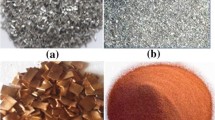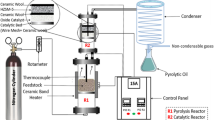Abstract
The liquefaction of rice hull (a typical agricultural waste) has been conducted with n-butanol solvent at various reaction temperatures ranging from 260 to 320°C. As a result, it was found that biomass conversion rates were increased with increasing temperature up to 320dgC. However, it was observed that its rate of conversion to liquid was about 83% at 320°C for 30 min. The crude oil yield with rice hull increased up to 1,273 mg/g/L at 300°C, but the yield of Fraction 1 at 280°C was raised suddenly, and peaked at 2 times that of the initial input amount of feedstock. Furthermore, the calorific values of crude oil and Fraction 1 from rice hull were about 5,843 and 8,061 kcal/kg and were enhanced 163 and 225%, respectively, relative to its feedstock as rice hull, respectively. Fraction 1 may be suitable as an alternative liquid fuel of gasoline, based on an engine performance test. Sixty species of organic compounds in crude oil were categorized into 8 classes of compounds, including acids, alcohols, aliphatic hydrocarbons, ethers, esters, ketones, phenol, and aromatics, and others. In the crude oil from rice hull, the most common chemical types were esters and ethers accounting for 32.0 and 19.2% of the total extract, respectively. Analysis of Fraction 1 revealed that the main chemical components were C5H12O, C7H14O2, C8H16O2, and C12H26O2. Therefore, for producing clean and green fuel energy with plant biomass liquefaction it is necessary to further investigate crude oil and to further refine Fraction 1 through catalytic cracking or hydro-de-oxygenation (HDO).
Similar content being viewed by others
References
Park, W. K., N. B. Park, J. D. Shin, S. G. Hong, and S. I. Kwon (2011) Estimation of biomass resource conversion factor and potential production in agricultural sector. Kor. J. Environ. Agriculture 30: 252–260.
Application of biomass energy technologies (1993) (Habitat) United Nations Center for Human Settlement. Nairobi.
Bridgewater, A. V. and G. Grassi (1991) Biomass pyrolysis liquids upgrading and utilization. England: Elsevier Applied Science.
Probstein, R. F. and R. E. Hicks (1982) Synthetic fuels. NY: McGraw-Hill Book Company.
Zhong, C. L. and X. M. Wei (2004) A comparative experimental study on the liquefaction of wood. Energy 29: 1731–1741.
Minowa, T., T. Kondo, and T. S. Sudirjo (1998) Thermochemical liquefaction of Indonesian biomass residues. Biomass Bioenergy 14: 517–524.
Maldas, D. and N. Shiraishi (1997) Liquefaction of biomass in the presence of phenol and H2O using alkalies and salts as the catalyst. Biomass and Bioenergy 12: 273–279.
Selhan, K., B. Thallada, M. Akinori, S. Yusaku, and U. Azhar (2004) Low temperature hydrothermal treatment of biomass: Effect of reaction parameters on products and boiling point distributions. Energy and Fuels 18: 234–241.
Yan, Y. J., J. Xu, T. C. Li, and Z. W. Ren (1999) Liquefaction of sawdust for liquid fuel. Fuel Proc. Technol. 60: 135–143.
Tako, M., N. Akihiro, U. Chiyo, O. Munetaka, I. Naoki, and S. Toshmitsu (1997) Liquefaction of microalgae with iron catalyst. Fuel 76: 1043–1048.
Qian, Y. J., C. J. Zuo, J. Tan, and J. H. He (2007) Structure analysis of bio-oils from sub-and supercritical water liquefaction of woody biomass. Energy 32: 196–202.
Qu, Y. X., X. M. Wei, and C. L. Zhong (2003) Experimental study on the direct liquefaction of Cunninghamialanceolata in water. Energy 28: 597–606.
Demirbas, A. (2000) A mechanism of liquefaction and pyrolysis reactions of biomass. Energy Conversion and Management 41: 633–646.
Demirbas, A. (1994) Chemicals from forest products by efficient extraction methods. Fuel Sci. Technol. Internat. 12: 417–431.
Tarabanko, V. E., G. R. Gulbis, and A. V. Kudrashev (1989) Liquefaction of wood with alkali metal formats at atmospheric pressure. Khimiya Drevesiny 1: 95–99.
Ogi, T. and S. Yokoyama (1993) Liquid fuel production from wood biomass by direct liquefaction. Sekiyu Gakkaishi 36: 73–84.
Demirbas, A. (1998) Aqueous glycerol delignification of wood chips and ground wood. Bioresour. Technol. 63: 179–185.
Minowa, T., T. Ogi, Y. Dote, and S. Yokoyama (1994) Effect of lignin content on direct liquefaction of bark. Internat. Chem. Eng. 34: 428–430.
Shin, J. D., Y. Baek, S. G. Hong, S. I. Kwon, W. K. Park, and S. W. Park (2010) Study on crude oil productions and its practice with rice hull as treated in various supercritical solvents on application of liquefaction technology. J. Kor. Organic Resour. Recycling Associat. 18: 110–118.
Liang, L., Z. Mao, Y. Li, C. Wan, T. Wang, and L. Zhang (2006) Liquefaction of crop residues for polyol production. BioResources 1: 248–256.
Ucart, S. and A. R. Ozkan (2008) Characterization of products from the pyrolysis of rapeseed oil cake. Bioresour. Technol. 99: 8771–8776.
Minowa, T., M. Masanori, D. Yutaka, O. Tomoko, and Y. Shin-ya (1995) Oil production from garbage by thermochemical liquefac tion. Biomass and Bioenergy 8: 117–120.
Wang, C., J. X. Pan, J. H. Li, and Z. Y. Yang (2008) Comparative studies of products produced from four different biomass samples via deoxy-liquefaction. Bioresource Technol. 99: 2778–2786.
Wang, T., L. Zhang, D. Li, J. Yin, S. Wu, and Z. Mao (2008) Mechanical properties of polyurethane foams prepared from liquefied corn stove with PAPI. Boiresour. Technol. 99: 2265–2268.
Zou, S. P., Y. L. Wu, M. D. Yang, and J. M. Tong (2009) Thermochemical catalytic liquefaction of the marine microalgae Dunaliellatertiolecta and characterization of bio-oils. Energy Fuels 23: 3753–3758.
Author information
Authors and Affiliations
Corresponding author
Rights and permissions
About this article
Cite this article
Shin, J., Hong, SG., Choi, WS. et al. Crude oil production and classification of organic compounds on super-critical liquefaction with rice hull. Biotechnol Bioproc E 18, 956–964 (2013). https://doi.org/10.1007/s12257-013-0122-x
Received:
Revised:
Accepted:
Published:
Issue Date:
DOI: https://doi.org/10.1007/s12257-013-0122-x




